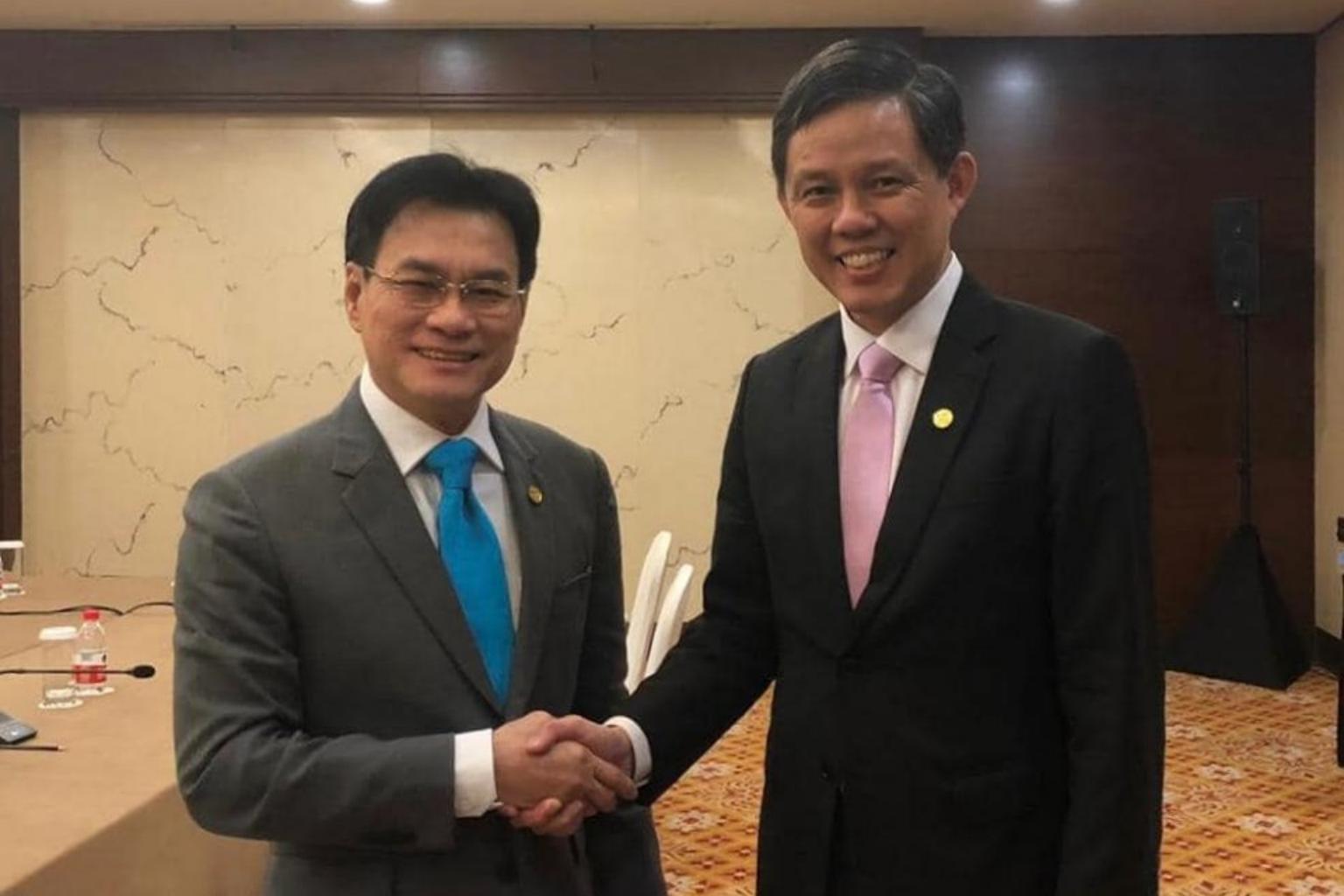Moderate progress after latest round of ministerial talks for RCEP trade pact
Sign up now: Get ST's newsletters delivered to your inbox

Trade and Industry Minister Chan Chun Sing with Thai Deputy Prime Minister and Minister of Commerce Jurin Laksanawisit on the sidelines of the Asean Economic Ministers Caucus Meeting on Aug 2, 2019.
PHOTO: CHAN CHUN SING/FACEBOOK
Follow topic:
BEIJING - Trade ministers negotiating the largest trade pact in the world appears to have made moderate progress after a day of talks in Beijing, calling into question if a deal can be sewn up by the end of this year.
Amid a climate of urgency brought on by the deepening trade war between US and China and a global slowdown, the officials from 16 countries only managed to conclude three additional annexes: on telecommunication services, financial services and professional services.
If signed, the Regional Comprehensive Economic Partnership (RCEP) comprising the 10-member states of Asean and six of its free-trade-agreement partners - China, Japan, South Korea, Australia, New Zealand and India - will be the world's biggest regional trade agreement.
It covers nearly half of the world's population, a third of the global economy and more than a quarter of cross-country trade.
At the end of the talks on Saturday (Aug 3), the number of concluded chapters remained the same as a year ago: seven out of 18.
The ministers said in a joint statement that some of the remaining chapters or annexes were nearly complete, and they were pleased that "over two thirds of market access negotiations have reached mutually satisfactory outcomes".
Market access has been a challenging issue, given that the non-Asean nations do not have free trade agreements among themselves.
The ministers urged all countries to find "pragmatic and solution-oriented approaches to narrow divergence on the various remaining issues", and said talks would intensify.
With rising uncertainties casting a pall over global growth, it was "in the region's collective interest and highest priority to conclude a modern, comprehensive, high quality, and mutually beneficial RCEP in 2019, as mandated by the 16 RCEP leaders," the ministers said.
Working-level teams recently met for a 27th round of talks (July 22 to 31) in Zhengzhou, the capital city of Henan province, and discussed issues including investment, intellectual property rights, e-commerce, trade of goods and services and rules of origin.
Singapore's Trade and Industry Minister Chan Chun Sing, who was at the talks on Saturday, said in a Facebook post that there was "good progress" but the months ahead would be "critical" for negotiations.
He said: "We agreed that it is important to exercise maximum flexibility to resolve the remaining issues".
Before the talks, Chinese Vice-Premier Hu Chunhua said that the deal was 80 per cent completed, but acknowledged that there were still sticking points such as tariff reductions and market access.
Negotiations on the mega trade pact started in 2013, but progress has been slow. Officials have acknowledged the significant obstacles in the way: 16 countries at different phases of economic development, with different amounts of trust, pushing for different levels of standards in the agreement.
One main stumbling block has been India's reluctance to get on board, worried that the deal would open the doors to Chinese goods flooding its market. Especially concerned are farmers who believe the removal of tariffs would make them uncompetitive.
A Hindu nationalist group, the Rashtriya Swayamsevak Sangh, linked to Prime Minister Narendra Modi's ruling Bharatiya Janata Party, told Reuters before the talks that the government was facing opposition from sectors ranging from agriculture, automobile, steel to electronic products and was unlikely to sign the pact.
In what was seen as a signal to the other RCEP partners, Indian Commerce Minister Piyush Goyal pulled out days before the Beijing talks, citing parliamentary commitments and sending his vice-minister instead.
India also wants free movement of talent; something other countries are not so keen on.
Anxious to get the deal through, China was said to have floated the idea of an "Asean-plus three" agreement which would exclude not only India, but also Australia and New Zealand.
Beijing sees RCEP not only as a buffer to the fallout from the trade war, but an opportunity for it to stand out as an Asian leader promoting a regional order and greater economic integration within this space.
It is Asean's largest trading partner, chalking up US$292 billion in trade with the grouping in the first six months of this year.
There were also concerns ahead of Saturday's talks that the escalating row between South Korea and Japan could spill over into the discussions.
South Korean trade minister Yoo Myung-hee and her Japanese counterpart Hiroshige Seko sat next to each other but did not speak during the opening ceremony.
The two countries have been locked in a bitter dispute over trade and compensation for wartime forced labour. On Friday, Japan removed South Korea from a favoured trading partners list, prompting Seoul to retaliate.
Possibly pre-empting tensions during the talks, Vice-Premier Hu in his speech urged countries to "make an effort to be considerate of one another".
Associate Professor Nimesh Salike at the International Business School Suzhou of Xi'an Jiaotong-Liverpool University said prospects of sewing up the deal this year looked bleak.
"But if there is a very strong willpower, especially on the side of China, there is still hope they are able to make it," he said.
"China is under pressure from the US, it wants to champion a multilateral trade system that will help it become a leader in the region. It has very strong motivation to conclude this deal by this year, so it may go ahead with some lavish concessions towards India."

